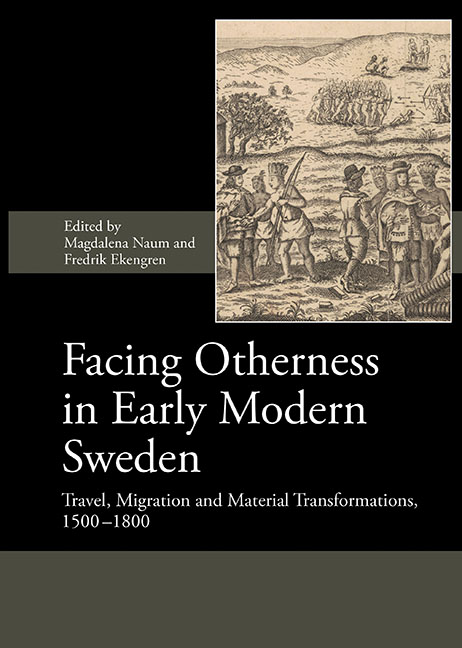Book contents
- Frontmatter
- Contents
- List of Illustrations
- List of Contributors
- Preface
- List of Abbreviations
- I Material Transformations
- II Migration and Neighbourly Interactions
- Introduction
- 6 Marrying “the Other”: Crossing Religious Boundaries in the Eastern Borderlands of the Kingdom of Sweden in the 17th Century
- 7 Ideas from Abroad: German Weavers as Agents of Large-Scale Cloth Production and a Continental Lifestyle in 17th-Century Sweden
- 8 Foreign Merchants in Early Modern Sweden: A Case of Intermarriage, Trade and Migration
- 9 Aspects of “British” Migration to Sweden in the 17th Century
- 10 Commodities, Consumption and Forest Finns in Central Sweden
- 11 Encountering “the Other” in the North – Colonial Histories in Early Modern Northern Sweden
- 12 Lapland's Taxation as a Reflection of “Otherness” in the Swedish Realm in the 17th and 18th Centuries: Colonialism, or a Priority Right of the Sami People?
- III Overseas Travel
- IV Conclusions
- Index
7 - Ideas from Abroad: German Weavers as Agents of Large-Scale Cloth Production and a Continental Lifestyle in 17th-Century Sweden
from II - Migration and Neighbourly Interactions
Published online by Cambridge University Press: 23 July 2019
- Frontmatter
- Contents
- List of Illustrations
- List of Contributors
- Preface
- List of Abbreviations
- I Material Transformations
- II Migration and Neighbourly Interactions
- Introduction
- 6 Marrying “the Other”: Crossing Religious Boundaries in the Eastern Borderlands of the Kingdom of Sweden in the 17th Century
- 7 Ideas from Abroad: German Weavers as Agents of Large-Scale Cloth Production and a Continental Lifestyle in 17th-Century Sweden
- 8 Foreign Merchants in Early Modern Sweden: A Case of Intermarriage, Trade and Migration
- 9 Aspects of “British” Migration to Sweden in the 17th Century
- 10 Commodities, Consumption and Forest Finns in Central Sweden
- 11 Encountering “the Other” in the North – Colonial Histories in Early Modern Northern Sweden
- 12 Lapland's Taxation as a Reflection of “Otherness” in the Swedish Realm in the 17th and 18th Centuries: Colonialism, or a Priority Right of the Sami People?
- III Overseas Travel
- IV Conclusions
- Index
Summary
The Royal Chartered Textile Manufacture (Vantmakeriet) established in Jönköping in 1620 relied on the modes of production and skills of German weavers whose arrival significantly increased the town's population. Recent excavations have revealed a vivid picture of the material culture of this group with its marked preference for imported food and maintenance of its members’ urban, continental lifestyle. But what can be said about the relationship between the German craftsmen and the Swedish population? In what ways were the locals adopting new lifestyles? What were the lasting results of this meeting between local and continental ways of life? This chapter addresses these questions.
Narratives of the encounter with the “Other” in early modern Sweden, its hinterland and newly-acquired overseas territories have in recent years often focused on colonialism and exploitation, and rightly so. This aspect has to a great extent been neglected, ignored or treated with indulgence in a country so much of whose self-image since World War II has been built around an idea of Sweden as a paragon of virtues, both human and political. The fact that Sweden too has a tainted colonial past, in many respects comparable to several other European countries, has been a salutary, albeit hard lesson to take in. The slave forts in western Africa, the New Sweden colony on the Delaware River, the silver mines in Sápmi and many other endeavours in the early modern period were all part of the same picture: the ambition of a relatively poor and sparsely-populated country on the northern fringes of Europe whose leaders wanted to play an active part on the political stage of the continent. And acquiring colonies was an important element in that scheme. The problem was that Sweden never had the muscle to compete with the great sea powers of the 17th century and consequently lost its short-lived possessions overseas. The internal colonization of Sápmi (Lapland) gave far better returns. And it still does to this very day, despite continuing infringement on the rights of the Sami people. These are topics that beg discussion, both from a historical/ archaeological point of view and as political matters of today.
- Type
- Chapter
- Information
- Facing Otherness in Early Modern SwedenTravel, Migration and Material Transformations 1500–1800, pp. 125 - 144Publisher: Boydell & BrewerPrint publication year: 2018
- 1
- Cited by



